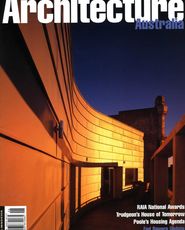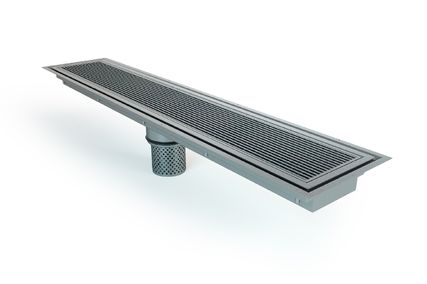 | PACIFIC EDGE: CONTEMPORARY
ARCHITECTURE ON THE PACIFIC RIM
Edited by Peter Zellner with essays by
Aaron Betsky, Davina Jackson and
Akira Suzuki, Thames & Hudson, $85.
Within three years of scoring his B.Arch from
RMIT, precocious Peter Zellner (a 29-year-old
American now at Harvard) has produced
this hardcover survey of works by 33 firms
from east Asia, the west Americas and
Australasia. Call me biased (as the
antipodean essayist) but I’m enthusiastic
about this volume: it’s a classy exploration of
an attractive, spurious idea: “the architecture
of the new Pacific century”. Compared with
Peter Cook and Rosie Llewellyn-Jones’ The
New Spirit in Architecture—a 1991 Rizzoli
anthology—Zellner’s Pacific Edgestacks up
splendidly; it has fewer architects and much
less white space but many more
photographs, drawings and words, generally
well chosen and crisply presented. Of
course, the choice of Australian architects—
Stephen Varady, Kerstin Thompson, Lyon
Architects, Dawson Brown and Clare
Design—will be controversial: cries of ‘what
about Durbach Block … Tom Kovac …
Donovan Hill (etc)’ are inevitable. Aside from
such pointless grumbles, readers will
appreciate the diversity of design
approaches. Note, the annointed 33 are not
cobbled together in region-based sections;
they’re marshalled into five themes which
Zellner considers relevant to current
architecture on our side of the planet. His
section titles are Modernist Legacies, Edge
Conditions, Dense Cities/Sprawl Cities,
Tectonics and Media-Tectonics. These
angles are explored in his introduction and
essays from three observers in Tokyo, San
Francisco and Sydney. SUSTAINABLE HOUSE:
LIVING FOR OUR FUTURE
By Michael Mobbs, Choice Books, $30.
Sydney development lawyer and community
activist Michael Mobbs has devoted his last
five years to an experiment still unusual in
cities: renovating and promoting his family’s small Victorian terrace house as a case
study of techniques for environmental
equilibrium. This book explains what’s been
done, how and why—with many mono
photos, drawings and charts to aid
comprehension. The author makes some
impressive (uncorroborated) claims for the
house’s annual performance: that it saves
102,000 litres of water, disposes of 100,000
litres of sewage, produces 100,000 litres of
drinkable water, recycles several tonnes of
newspaper and scraps, produces $1119.30
worth of clean energy and reduces carbon
dioxide pollution from power stations by 8.3
tonnes. However, the cost-benefit discussion
makes it clear that these advantages are
probably beyond the financial orbit of many
eco-enthusiasts—and it’s significant that
Mobbs and his partner Heather Armstrong
persuaded various suppliers to install their
products free or at discount in return for
promotional opportunities. Yet NSW Premier Bob Carr was
| impressed enough with the
project to invite a battalion of television
crews and print journos into Mobbs’
lilliputian living room for a never-to-be-forgotten
press conference that spilled out to
his recycled timber deck above the reed
pond and the worm farm. JANET LAURENCE
An Art in Australia Monograph, by Peter
Emmett, Craftsman House, $33.
Janet Laurence is a serious candidate for the
mantle of Australia’s leading public artist of
this decade. She’s certainly among the
handful to be trusted by fastidious architects
to elevate the aesthetics of their projects.
Ironically, many modernists are seduced by
her ethereal (dare one say post-modern?)
excursions into the archaic realms of
alchemy and calligraphy, and the mysteries
of the body and brain. Regrettably, this slim
volume seems to be her first proper
monograph (some lesser and younger artists
have been honoured with several thumping
tomes). Anyway, it’s a fine photographic
survey of her last decade of work, with an
illuminating essay by Dr Peter Emmett, the historian and philosopher who was
Laurence’s key client on her most
proclaimed work, ‘The Edge of the Trees’
(that glade of whispering trunks outside the
Museum of Sydney). Since that 1994
collaboration with Aboriginal artist Fiona
Foley and Denton Corker Marshall’s Sydney
director Richard Johnson, Laurence has
done fascinating things around the country
with long rods of timber and layers of
stained and printed glass. Watch out for her
smoking test tubes under DCM bridges at
the Olympics.
QVB: AN IMPROBABLE STORY
Edited by Suzanne Stirling, text by
Helen Ivory, interviews by Anne-Marie
Moody, Ipoh, $60 (cloth), $40 soft cover.
This book commemorates a centennial
which almost didn’t happen. The Queen
Victoria Building—Sydney’s former city
markets—was regularly on the verge of
demolition during its stages of dormancy this
century. But in the heritage-conscious 1980s
a Malaysian development company, Ipoh
Garden Berhard, won a contract to transform
the copper-roofed, sandstone monument
(occupying a whole city block) into a
prestigious three-storey shopping arcade,
with Rice Daubney as architects. After more
than a decade of prosperous trading, Ipoh
has published this illustrated history, edited
by former QVB manager Suzanne Stirling
and embellished with great quotes from
people who fondly recall different aspects
and incarnations. SOLID, SAFE. SECURE:
BUILDING ARCHIVES REPOSITORIES
IN AUSTRALIA
By Ted Ling, National Archives of
Australia, $30.
If you’re planning a library or archives
building soon, this is a must-have manual.
If not, it isn’t.
Notices by Davina Jackson. Architext
bookshops are at Tusculum, Sydney,
ph 02 9356 2022 and 41 Exhibition Street,
Melbourne, ph 03 9650 3474. |
















